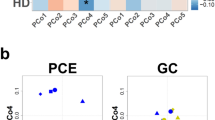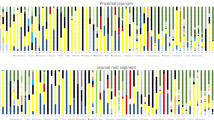Abstract
Background
We previously investigated fecal flora of the pouch after total proctocolectomy using terminal restriction fragment polymorphism analysis. Although the results of the cluster analysis demonstrated clearly that bacterial populations, including an unidentified bacteria generating a 213-bp PCR fragment, moved toward a colon-like community in the pouch, it did not track changes in the individual species of fecal bacteria.
Aims
The aim of the present study was to estimate genome copy number of ten bacterial species, clusters, groups, or subgroups (including the bacteria generating 213-bp fragment in the previous study) in feces samples from pouches at various times following ileostomy closure.
Methods
A total of 117 stool samples were collected from patients with ulcerative colitis after surgery as well as healthy volunteers. We used real-time polymerase chain reaction of the 16S rRNA gene to estimate genome copy numbers for the nine bacterial populations and the bacteria generating 213-bp fragment after identification by DNA sequencing.
Results
We demonstrated a time-dependent increase in the number of anaerobic and colon-predominant bacteria (such as Clostridium coccoides, C. leptum, Bacteroides fragilis and Atopobium) present in proctocolectomy patients after stoma closure. In contrast, numbers of ileum-predominant bacterial species (such as Lactobacillus and Enterococcus faecalis) declined.
Conclusions
Our data confirm previous findings that fecal flora in the pouch after total proctocolectomy changes significantly, and further demonstrate that the number and diversity of ileal bacteria decreases while a more colon-like community develops. The present data are essential for the future analysis of pathological conditions in the ileal pouch.





Similar content being viewed by others
References
Fukushima K, Haneda S, Takahashi K, et al. Molecular analysis of colonic transformation in the ileum after total colectomy in rats. Surgery. 2006;140:93–99.
Kohyama A, Ogawa H, Funayama Y, et al. Bacterial population moves toward a colon-like community in the pouch after total proctocolectomy. Surgery. 2009;145:435–447.
Matsuki T, Watanabe K, Fujimoto J, Takada T, Tanaka R. Use of 16S rRNA gene-targeted group-specific primers for real-time PCR analysis of predominant bacteria in human feces. Appl Environ Microbiol. 2004;70:7220–7228.
Rinttila T, Kassinen A, Malinen E, Krogius L, Palva A. Development of an extensive set of 16S rDNA-targeted primers for quantification of pathogenic and indigenous bacteria in faecal samples by real-time PCR. J Appl Microbiol. 2004;97:1166–1177.
Ohge H, Furne JK, Springfield J, Rothenberger DA, Madoff RD, Levitt MD. Association between fecal hydrogen sulfide production and pouchitis. Dis Colon Rectum. 2005;48:469–475.
Roediger WE, Duncan A, Kapaniris O, Millard S. Sulphide impairment of substrate oxidation in rat colonocytes: a biochemical basis for ulcerative colitis? Clin Sci Lond. 1993;85:623–627.
Nadkarni MA, Martin FE, Jacques NA, Hunter N. Determination of bacterial load by real-time PCR using a broad-range (universal) probe and primers set. Microbiology. 2002;148:257–266.
Fite A, Macfarlane GT, Cummings JH, et al. Identification and quantitation of mucosal and faecal desulfovibrios using real time polymerase chain reaction. Gut. 2004;53:523–529.
Menard JP, Fenollar F, Henry M, Bretelle F, Raoult D. Molecular quantification of Gardnerella vaginalis and Atopobium vaginae loads to predict bacterial vaginosis. Clin Infect Dis. 2008;47:33–43.
Bartosch S, Fite A, Macfarlane GT, McMurdo ME. Characterization of bacterial communities in feces from healthy elderly volunteers and hospitalized elderly patients by using real-time PCR and effects of antibiotic treatment on the fecal microbiota. Appl Environ Microbiol. 2004;70:3575–3581.
Langendijk PS, Schut F, Jansen GJ, et al. Quantitative fluorescence in situ hybridization of Bifidobacterium spp. with genus-specific 16S rRNA-targeted probes and its application in fecal samples. Appl Environ Microbiol. 1995;61:3069–3075.
Coffey JC, Rowan F, Burke J, Dochery NG, Kirwan WO, O’Connell PR. Pathogenesis of and unifying hypothesis for idiopathic pouchitis. Am J Gastroenterol. 2009;104:1013–1023.
Nasmyth DG, Godwin PG, Dixon MF, Williams NS, Johnston D. Ileal ecology after pouch-anal anastomosis or ileostomy. A study of mucosal morphology, fecal bacteriology, fecal volatile fatty acids, and their interrelationship. Gastroenterology. 1989;96:817–824.
Smith FM, Coffey JC, Kell MR, O’Sullivan M, Redmond HP, Kirwan WO. A characterization of anaerobic colonization and associated mucosal adaptations in the undiseased ileal pouch. Colorectal Dis. 2005;7:563–570.
Sato S, Fukushima K, Naito H, et al. Induction of 11beta-hydroxysteroid dehydrogenase type 2 and hyperaldosteronism are essential for enhanced sodium absorption after total colectomy in rats. Surgery. 2005;137:75–84.
Swidsinski A, Ladhoff A, Pernthaler A, et al. Mucosal flora in inflammatory bowel disease. Gastroenterology. 2002;122:44–54.
Marteau P, Lepage P, Mangin I, et al. Review article: gut flora and inflammatory bowel disease. Aliment Pharmacol Ther. 2004;20:18–23.
Lepage P, Seksik P, Sutren M, et al. Biodiversity of the mucosa-associated microbiota is stable along the distal digestive tract in healthy individuals and patients with IBD. Inflamm Bowel Dis. 2005;11:473–480.
Sokol H, Seksik P, Rigottier-Gois L, et al. Specificities of the fecal microbiota in inflammatory bowel disease. Inflamm Bowel Dis. 2006;12:106–111.
Christl SU, Eisner HD, Dusel G, Kasper H, Scheppach W. Antagonistic effects of sulfide and butyrate on proliferation of colonic mucosa: a potential role for these agents in the pathogenesis of ulcerative colitis. Dig Dis Sci. 1996;41:2477–2481.
Duffy M, O’Mahony L, Coffey JC, et al. Sulfate-reducing bacteria colonize pouches formed for ulcerative colitis but not for familial adenomatous polyposis. Dis Colon Rectum. 2002;45:384–388.
Acknowledgments
A part of the results were generated by using the facilities of the Biomedical Research Core of Tohoku University Graduate School of Medicine. This work was supported in part by Health and Labour Sciences Research Grants for research on intractable diseases from the Ministry of Health, Labour and Welfare of Japan.
Conflict of interest
The authors declare that they have no conflict of interest.
Author information
Authors and Affiliations
Corresponding author
Rights and permissions
About this article
Cite this article
Hinata, M., Kohyama, A., Ogawa, H. et al. A Shift from Colon- to Ileum-Predominant Bacteria in Ileal-Pouch Feces Following Total Proctocolectomy. Dig Dis Sci 57, 2965–2974 (2012). https://doi.org/10.1007/s10620-012-2165-9
Received:
Accepted:
Published:
Issue Date:
DOI: https://doi.org/10.1007/s10620-012-2165-9




